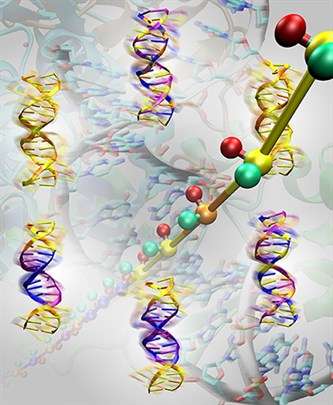Newly developed model of DNA sheds light on molecule's flexibility

Knowledge of how DNA folds and bends could offer new perspective on how it is handled within cells while also aiding in the design of DNA-based nano-scale devices, says a biomedical engineer at Texas A&M University whose new motion-based analysis of DNA is providing an accurate representation of the molecule's flexibility.
The model, which is shedding new light on the physical properties of DNA, was developed by Wonmuk Hwang, associate professor in the university's Department of Biomedical Engineering, and his Ph.D. student Xiaojing Teng. Hwang uses computer simulation and theoretical analysis to study biomolecules such as DNA that carry out essential functions in the human body. His latest model, which provides a motion-based analysis of DNA is detailed in the scientific journal ACS Nano.
In addition to housing the genetic information needed to build and maintain an organism, DNA has some incredibly interesting physical properties that make it ideal for the construction of nanodevices, Hwang notes. For example, the DNA encompassed within the nucleus of one human cell can extend to four feet when stretched out, but thanks to a number of folds, bends and twists, it remains in a space no bigger than one micron – a fraction of the width of a human hair. DNA also is capable of being programmed for self-assembly and disassembly, making it usable for building nano-mechanical devices.
Understanding its unique physical properties is key to unlocking DNA's potential as a building tool, but previous studies, Hwang notes, have provided limited information about DNA flexibility. This is largely due to their reliance on static structural models of the molecule, Hwang says. Unlike those studies, Hwang's model incorporates an atomistic simulation so that inherent thermal motion of DNA can be analyzed. Hwang and his team are then able to measure how the DNA strand deforms during this movement.
The key concept in the analysis, Hwang explains, is known as 'principal axis,' which basically denotes where a rod can most easily bend or where it is the stiffest. For instance, a ruler can bend most easily near its flat side while it is the most difficult to bend near its thin edge, he says. Similar behavior can be seen for DNA. This motion-based analysis, Hwang says, has already resulted in some key findings and biological insights about DNA.
For example, a DNA double helix chain, Hwang notes, can have varying flexibility based on how the sequences of nucleotides on the chain are organized. What's more, Hwang's model revealed DNA responding in specific ways to physical forces – either twisting or bending. This response can be seen when proteins bind to DNA, Hwang explains. When proteins bind without much energetic cost they tend to twist DNA, but high-energy binding results in more of a bending of DNA, Hwang says.
These tiny-sized reactions, Hwang notes, could have big implications, particularly when it comes to using DNA as molecular building blocks for nanodevices such as drug delivery systems and circuitry in plasmonic devices. Building incredibly small yet advanced devices is a major goal of nanotechnology, and doing it with DNA isn't as far fetched as it sounds. Throughout the last few years, researchers have used the genetic material to build a number of nano-sized constructs, shaping it into various three-dimensional shapes such as boxes that can open and close. The process, known as DNA origami, is still in its relative infancy, but the information provided by Hwang's model could help researchers build more advanced constructs.
"Driving a car is one thing, but building it is another; you turn the key and step on the gas pedal, and the car moves – you can use it without any need to know what is happening inside the car," Hwang says. "But to truly engineer a better car, you must have knowledge about the properties of its components and how they are put together. The same hold true about DNA as it continues to be used for building these nanostructures, and we are providing a mechanical spec sheet for it through our analysis."
More information: Xiaojing Teng et al. Elastic Energy Partitioning in DNA Deformation and Binding to Proteins, ACS Nano (2016). DOI: 10.1021/acsnano.5b06863
Journal information: ACS Nano
Provided by Texas A&M University


















